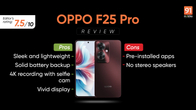Whenever a new phone series comes in, the ‘Pro’ or ‘Ultra’ models usually grab more limelight. This is because we assume that the standard variant would bear more or less the same features as the Pro models, but with some compromises. While this is true in many cases, every now and then, some phones pop up that defy this convention and show that regular variants can offer better value. When I got my hands on the OPPO Reno11 a couple of weeks back, I sincerely hoped that it would belong to this same category. Now that I have spent enough time with the phone, I can finally share my two cents on whether this phone is a great buy for its price or if you can look elsewhere.
Before I go ahead with my detailed OPPO Reno11 review, if you have not checked out our review for the Reno11 Pro, I would recommend that you give it a read and come back to find out how the regular variant fares against the Pro model to find out which phone makes more sense for you. Having said that, let’s dive deep into what the Reno11 has to offer.

Verdict
OPPO Reno11 is a solid camera phone that manages to click amazing pictures and has a pretty decent display. One thing to note here is that some other phones in its price bracket come with better processing power. While this phone would handle most of your everyday work, you will have to keep in mind that it is not a performance-centric smartphone.
Design and display
OPPO says that the design of the Reno11 has been inspired by nature. The brand has integrated silk and metal sequins to give the back cover a sparkling and flowing texture. The Wave Green variant, which I received, is said to conjure “images of green sea waves under a clear sky with its Shimmering Silk Design.” Putting aside this poetic imagery, the phone indeed comes with an elegant design. There is a more subdued Rock Grey variant also available for those who prefer darker shades. However, my pick would definitely be Wave Green for this phone.


Moving on to the display, the 1.57mm bezels on the left and right sides of the curved display provide it with a 93 percent screen-to-body ratio. The 6.7-inch FHD+ AMOLED panel comes with 120Hz refresh rate and HDR10+ support. As we are talking about an AMOLED panel, there is no surprise that the display looks vibrant and offers deep blacks. While watching content on streaming apps, I got an immersive experience and as the phone felt light in my hand, I could hold it comfortably for hours at a stretch. Having said that, I was not particularly impressed by the peak brightness at offer here. The display offers a peak brightness of 800nits and this shows when you step outdoors and try to use the phone under direct sunlight. As many other mid-range phones now offer much better visibility outdoors, this is one aspect where the phone’s display falls short noticeably.
In overall use, I have to admit that I have recently started to appreciate flat displays more than the curved ones. While the curved displays look better aesthetically, in everyday usage, flat displays feel more functional.
Cameras
For a while there, I was seriously considering starting my review with the camera section itself. The Reno series from OPPO is well known for delivering phones with impressive camera hardware and features. Most of you reading my review might have even jumped directly to this section as you would likely be considering this phone primarily for its cameras. If you belong to this category, before I dive in deep, I’ll just say that you’ll be delighted with what I’m about to share.

Let’s get the nitty gritty out of the way first. The phone boasts an ‘Ultra-Clear Portrait Camera System’ with a 50MP primary camera with a Sony LYT600 sensor (1/1.95-inch sensor size) and an f/1.8 aperture lens. The primary camera comes with OIS support and a 26mm focal length. The phone ships with a 32MP portrait camera with a Sony IMX709 sensor (1/2.74-inch sensor size), an f/2 aperture lens, and a 47mm focal length. Finally, you get an 8MP ultra-wide camera with a Sony IMX355 sensor, an f/2.2 aperture lens, and a 112-degree field-of-view.
It is one thing to have good specs on paper but entirely another to deliver great shots. Keeping this in mind, I clicked pictures across different lighting conditions with the Reno11 and tried to make sure I covered most use cases that you would likely come across. These included daytime outdoor shots with good natural sunlight, daytime outdoor shots with less-than-ideal sunlight, indoor shots with artificial light, night-time shots with poor lighting, and nighttime shots with artificial lighting. Overall, I feel confident in saying that the Reno11 ships with a primary camera that is capable of taking some impressively detailed shots. The images I took had pretty accurate colours and the depth effect in portrait shots came out looking pretty good too.
As the phone has been said to come with an ‘Ultra-Clear Portrait Camera System’, it is imperative to talk about the quality of the portrait shots taken from the handset. The phone ships with what the brand has termed ‘Portrait Expert Engine’, which comes with multiple features such as facial recognition + subject separation, skin tone protection, clarity and facial enhancement, and portrait and environment merging. Notably, you get the option of clicking portrait shots in two focal lengths – 24mm and 47mm. In my experience, the portrait shots clicked by the handset offered decent edge detection, captured skin tones well, and produced shots that can be called ‘social-media ready’. I even took some ultra-wide shots with the phone to check out the tertiary and let’s just say they got the job done.
Moving along to the front camera, you get an OmniVision OV32C 32MP selfie camera with an f/2.4 aperture lens and 22mm focal length. Interestingly, the phone lets you record even 4K videos with the selfie camera. In my use, the phone clicked decent pictures with the front camera and recorded good-quality videos, but I felt like the videos recorded with the front camera could have been more stable, especially because its target audience would be vloggers who usually move around a lot.
Performance and software
The Reno11 is powered by a MediaTek Dimensity 7050 chipset, which is developed using a 6nm fabrication process. The chipset comes with two performance cores and six efficiency cores. The handset has 8GB of RAM and 8GB of Dynamic RAM and as far as internal storage is concerned, you get 128GB and 256GB options. This storage can further be expanded up to 2TB using a microSD card. To check out the phone’s capabilities, I played Battlegrounds Mobile India and NBA 2K Mobile on it. While playing these games on the phone, I didn’t face any stutter or lag. However, it is important to point out that I faced some lag in UI animations during my usage. While Reno11 handled most of the tasks well, if you’re looking for a performance-centric phone, you should know that some phones in this price segment are priced more affordably and come with more capable chipsets.

In the Geekbench single-core and multi-core tests, Reno11 managed to get scores of 958 and 2317, respectively. In the AnTuTu benchmark, the phone managed to get a score of 535605. In the CPU Throttling test, the phone managed to retain 88 percent of its peak performance per the CPU Throttle test after running 50 threads for 30 minutes.
The phone runs ColorOS 14 out of the box and with this iteration comes Trinity Engine, a computing system that aims to offer fast and smooth performance. The Trinity Engine lets you keep up to 28 apps running in the background for up to 72 hours to let you multitask by switching between apps more efficiently. By learning the users’ habits, the phone also optimised the battery utilisation to ensure you get a decent backup.
There are a couple of aspects of ColorOS 14 that I found to be especially handy. First is File Dock, which lets you save text or image files to easily use via drag-and-drop and Smart Touch, which lets you capture text and images that were not selectable by default.
Battery life and charging speed
The Reno11 houses a 5,000mAh battery and supports up to 67W SuperVOOC fast charging. This means you can get up to 33 percent charge in just 10 minutes and 100 percent charge in just 45 minutes.

OPPO claims that with its exclusive Battery Health Engine, it has also optimised the battery system to work effectively after four years for long-lasting battery durability. While testing this claim right now isn’t possible, what I can share is that I managed to get around 6 hours of screen-on time with this phone.
Final verdict
OPPO Reno11 shines in the camera department and is one of the best phones you can buy for portrait photography at its retail price of Rs 29,999. However, it is worth noting that the phone doesn’t come with similar horsepower as some other phones in this segment, such as the POCO X6 Pro (review). That said, the Reno11 has a distinct design that makes it stand out. Then there are software features onboard that will make your life more convenient. Talking about convenience, the handset supports 67W fast charging that can get it fully charged from 0 to 100 in just 45 minutes. These are all points that work in favour of the OPPO Reno 11, and it has to be said that if you’re looking for a phone primarily for photography, the smartphone could be a good fit.
Editor’s rating: 7.5 / 10
Reasons to buy:
- The primary camera sensor is capable of taking detailed shots
- Impressive 120Hz display
- 67W SuperVOOC fast-charging support is convenient
- Eye-catching design makes the phone look premium.
Reasons not to buy:
- Peak brightness is a bit underwhelming and makes it hard to use the phone outdoors
- The phone feels slippery in hand without a case.
- Other phones at this price have better processors




![[Update] OnePlus mistakenly announces Google Gemini Ultra AI coming to its phones later this year Thumbnail](https://www.91-cdn.com/hub/wp-content/uploads/2024/04/OnePlus-AI.jpg?tr=h-110,q-100,pr-true)







